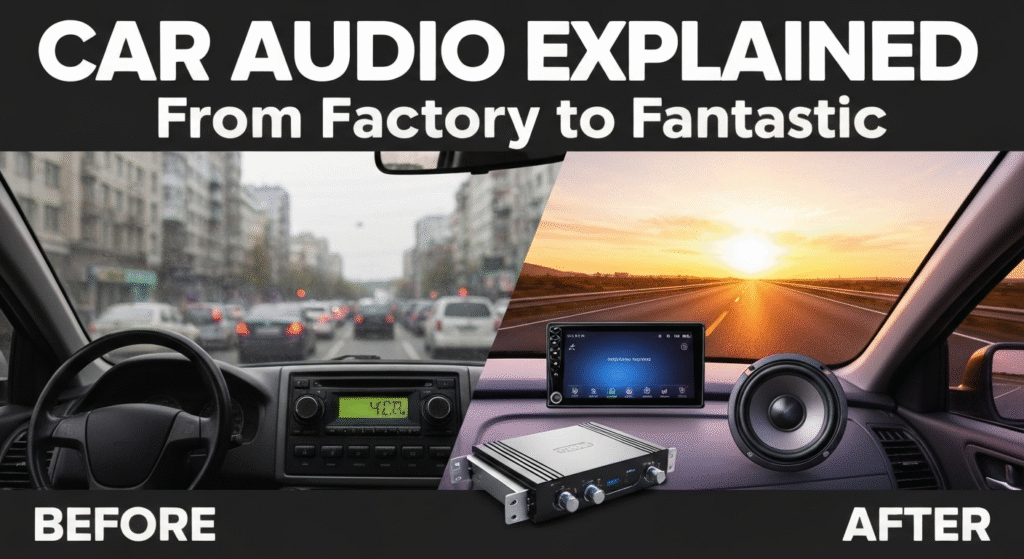Is the sound in your car flat, muddy, or just plain boring? You’re not alone. Most factory-installed car audio systems are built to a budget, not for performance. The result is often music that lacks clarity, depth, and excitement. But what if you could transform your daily commute into a front-row concert experience? It’s more achievable than you might think.
Over the last five years of working hands-on with these systems, I’ve helped countless drivers unlock the true potential of their car’s sound. My name is Sharmin, and I’ve learned that great audio isn’t magic; it’s about understanding how a few key components work together. You don’t need to be an engineer to grasp the basics. This guide will break down the core parts of any car audio system—the head unit, amplifier, and speakers—into simple, easy-to-understand terms.
The Three Pillars of Car Audio: The Core Components
Think of your car’s audio system like a team. For the team to win (and produce amazing sound), every player needs to do their job well. If one is weak, the whole team suffers. The three main players are the source, the power, and the voice.
- The Head Unit (The Brains): This is the component you interact with most. It’s the source of your music and the central command for your entire system.
- The Amplifier (The Muscle): This takes the weak audio signal from the head unit and gives it the power it needs to drive the speakers effectively.
- The Speakers (The Voice): These are the final pieces in the puzzle. They take the powerful electrical signal from the amp and convert it into the sound waves you actually hear.
Understanding the role of each component is the first step toward diagnosing what your current system lacks and planning a meaningful upgrade. Let’s break down each one.
The Brains of the Operation: The Head Unit (Stereo)
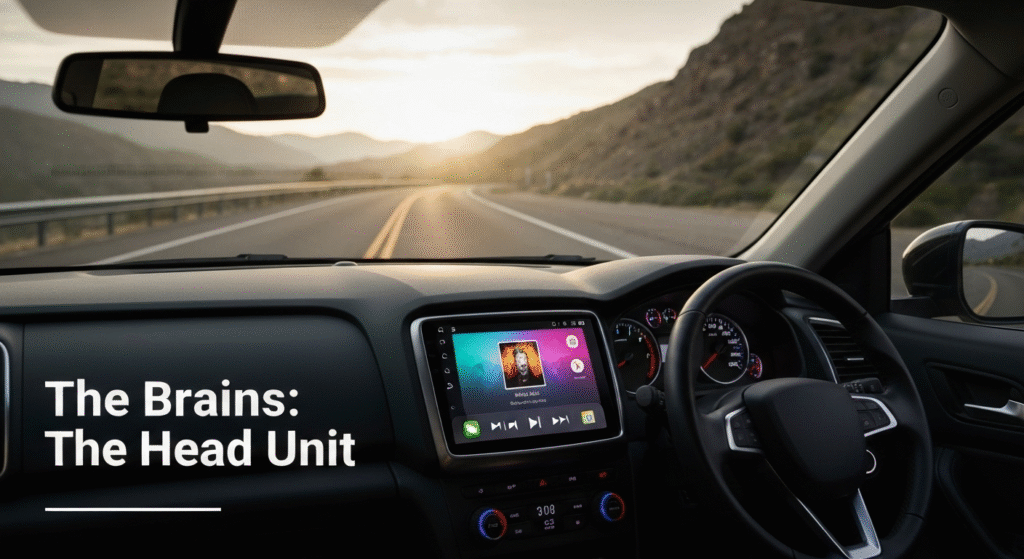
The head unit, also called a stereo or receiver, is the heart of your car’s entertainment system. It’s mounted in your dashboard and serves as the primary interface for everything you listen to. A common mistake is to overlook the head unit when planning an upgrade, but a new one can make a massive difference, even with your factory speakers.
What Does a Head Unit Actually Do?
Its job goes far beyond just playing a CD or a radio station. A modern head unit is a multi-function device responsible for:
- Source Selection: Letting you choose between radio, Bluetooth, USB, auxiliary inputs, and more.
- Volume Control: The most basic but essential function.
- Sound Shaping: Features like equalizers (EQs), bass boosters, and balance/fader controls allow you to tailor the sound to your liking.
- Sending the Signal: It generates the initial, low-power audio signal that gets sent to your amplifier. The quality of this initial signal is critical for the final sound.
Types of Head Units: Single-DIN vs. Double-DIN
When you start looking at aftermarket head units, you’ll immediately see the terms “Single-DIN” and “Double-DIN.” This simply refers to the size of the chassis. It’s a standard set by the Germans decades ago (DIN stands for Deutsches Institut für Normung), and it determines what will fit in your car’s dashboard.
- Single-DIN: The unit is 2 inches tall and 7 inches wide. These are the classic, smaller stereos.
- Double-DIN: The unit is 4 inches tall and 7 inches wide. These are larger and usually feature big touchscreens.
Here’s a simple comparison to help you choose:
| Feature | Single-DIN Head Unit | Double-DIN Head Unit |
| Size | 2 inches tall | 4 inches tall |
| Screen | Typically a smaller, text-based display. Some models have a motorized, retractable screen. | Large touchscreen display (usually 6-10 inches). |
| Features | Excellent for audio-focused builds. Often includes high-quality audio processors and pre-outs. | Ideal for multimedia. Supports features like Apple CarPlay, Android Auto, navigation, and backup cameras. |
| Best For | Drivers who prioritize pure sound quality and a simpler interface. Common in older vehicles. | Drivers who want a modern, integrated experience with smartphone connectivity and visual apps. |
Key Features to Look For
When shopping for a head unit, don’t get lost in the marketing buzz. Focus on the features that directly impact sound quality and usability.
- Connectivity: At a minimum, look for Bluetooth for wireless streaming and hands-free calls. USB ports are great for charging your phone and playing high-resolution audio files.
- Screen Type: For Double-DIN units, a capacitive touchscreen is much more responsive and feels like a modern smartphone, whereas a resistive screen requires more pressure to register a touch.
- Pre-amp Outputs (Pre-outs): This is perhaps the most important feature for future upgrades. Pre-outs provide a clean, un-amplified signal to send to an external amplifier. The higher the voltage of the pre-outs (e.g., 4V or 5V), the cleaner the signal will be, resulting in less background noise.
I once had a client with a newer Honda Civic who was unhappy with his sound but didn’t want to replace his speakers yet. We simply swapped his basic factory radio for a mid-range Double-DIN head unit with 4-volt pre-outs. The difference was immediate. The sound was cleaner, the bass was tighter, and the volume could go higher without distortion, all through the same factory speakers. It showed him just how much his original head unit was holding the system back.
The Muscle: Understanding the Amplifier (Amp)
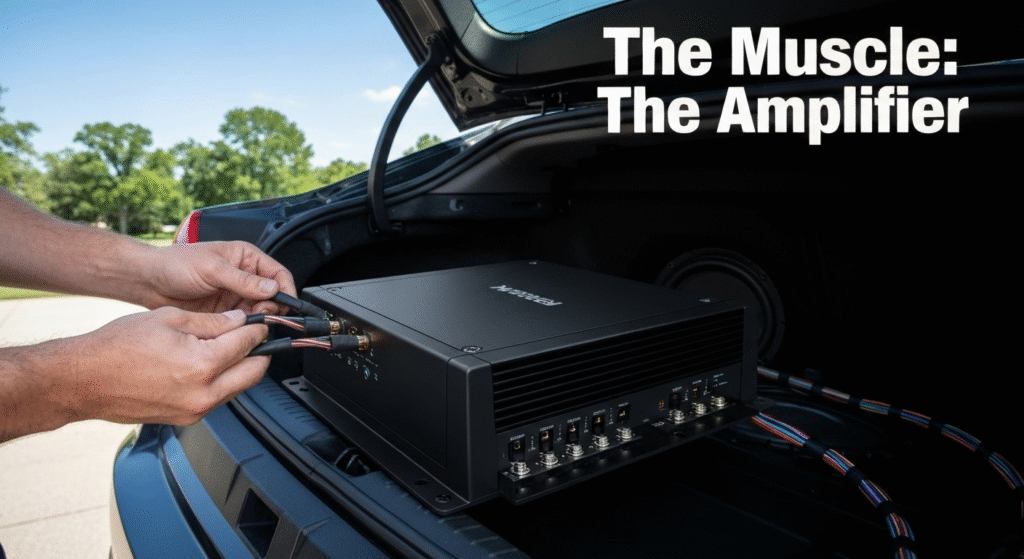
If the head unit is the brain, the amplifier is the heart and muscles. The small, built-in amplifier in a head unit typically delivers around 15-20 watts of continuous power per channel. While that’s enough to make sound, it’s not enough to make great sound, especially at higher volumes. An external amplifier provides clean, robust power to make your music come alive.
Why Do You Need an Amplifier?
A dedicated amplifier solves two major problems with factory systems: lack of power and distortion. When you turn up the volume on a basic head unit, it quickly runs out of clean power and starts sending a “clipped” or distorted signal to your speakers. This distortion is what makes the music sound harsh and can even damage your speakers over time.
An external amp provides significantly more clean power, allowing your speakers to play louder without strain. This extra power also provides better control over the speaker cone, resulting in tighter, more accurate bass and clearer high notes.
Key Amplifier Specifications Explained
Navigating amplifier specs can seem intimidating, but you only need to understand a few key terms.
- Channels: This refers to how many speakers the amp can power.| Amp Type | Best For || :— | :— || Monoblock (1-Channel) | Powering one or more subwoofers. || 2-Channel | Powering a single pair of speakers (e.g., front left and right). || 4-Channel | Powering two pairs of speakers (front and rear). The most common type. || 5-Channel | Powering an entire system: four speakers and a subwoofer from a single unit. |
- Power (RMS vs. Peak): This is critical. Peak Power is a largely meaningless marketing number that an amp can only produce for a fraction of a second. RMS (Root Mean Square) Power is the real number you should care about. It represents the continuous, real-world power the amplifier can deliver consistently. Always match the RMS power of your amplifier to the RMS power handling of your speakers.
- Amplifier Class: This refers to the amplifier’s internal design and affects its efficiency and sound quality. The two most common types in car audio are Class A/B (known for excellent sound quality but less efficient) and Class D (highly efficient, runs cooler, and is perfect for powering subwoofers).
Do I Always Need a Separate Amp?
Not necessarily, but it’s the single biggest step up in sound quality you can make after the head unit. You absolutely need an external amplifier if:
- You are adding a subwoofer. Subwoofers require a lot of power that no head unit can provide.
- You are installing high-quality component speakers. They are designed to handle more power than a head unit can supply.
- You want your music to be loud and clear without distortion.
For many people, a compact 4-channel amp that fits under a seat is the perfect solution to power the front and rear speakers, dramatically improving the entire listening experience.
The Voice: Choosing the Right Speakers
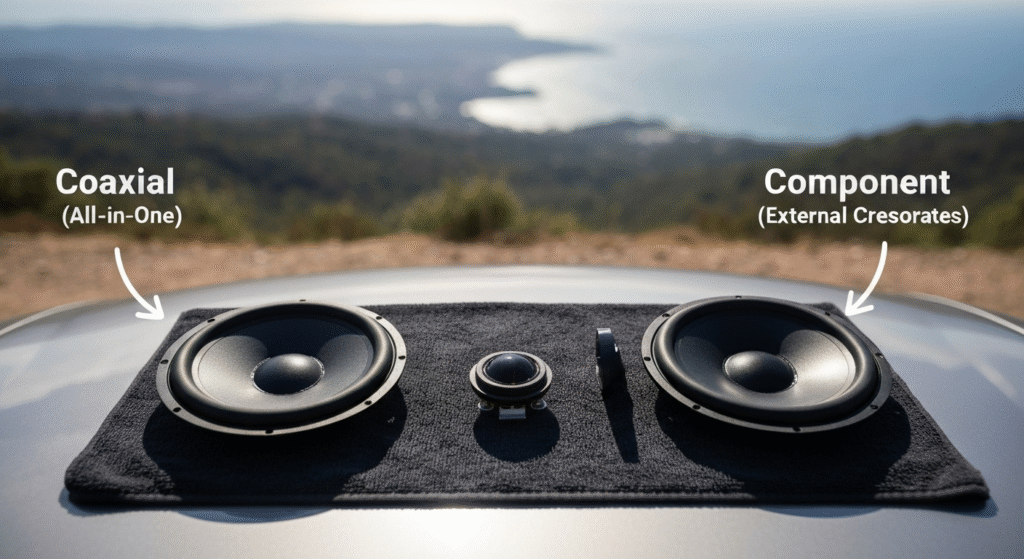
Speakers are the final link in the audio chain. They perform the amazing task of turning electrical energy into mechanical energy, vibrating to create the sound waves that travel to your ears. Upgrading from the cheap paper-cone speakers that come in most cars is often a night-and-day difference.
The Anatomy of a Car Speaker
A basic speaker has a few key parts. The cone (or diaphragm) moves back and forth to create sound. The voice coil and magnet form the motor that makes the cone move. The surround and spider are flexible parts that allow the cone to move freely while keeping it centered. In most car speakers, you’ll also find a smaller speaker called a tweeter mounted in the middle, which is designed to produce high-frequency sounds like cymbals.
Coaxial vs. Component Speakers: What’s the Difference?
This is one of the most common choices you’ll face when upgrading speakers. Both can be great options, but they are designed for different goals and installation complexities.
| Feature | Coaxial Speakers (“Full-Range”) | Component Speakers (“Separates”) |
| Design | The tweeter is mounted in the center of the woofer. All parts are in one simple unit. | The tweeter is a separate unit from the woofer. Includes an external crossover network. |
| Sound Quality | Good. A significant upgrade over factory speakers. Sound comes from a single point. | Excellent. Separating the tweeter allows for better placement (e.g., higher on the door or dashboard), creating a more realistic and immersive soundstage. |
| Installation | Easy. They typically drop right into the factory speaker locations. | More complex. Requires finding a place to mount the separate tweeters and crossovers. |
| Cost | Generally more affordable. | Generally more expensive due to higher quality materials and more parts. |
For a simple, effective upgrade, coaxial speakers are fantastic. For those who want the best possible sound imaging and clarity, component speakers are the way to go. I often recommend starting with a quality set of component speakers for the front doors, as this is where most of your soundstage comes from.
Important Speaker Specs to Know
Just like with amplifiers, a few key specifications will tell you most of what you need to know.
- Power Handling (RMS): Again, focus on the RMS number. This should match the RMS power output of your amplifier. Underpowering a speaker is just as bad as overpowering it.
- Sensitivity: Measured in decibels (dB), this tells you how efficiently a speaker converts power into volume. A speaker with a higher sensitivity rating (e.g., 90 dB or more) will play louder with less power, making it a good choice if you’re using a low-powered head unit.
- Frequency Response: This tells you the range of sounds the speaker can reproduce, from low bass to high treble, measured in Hertz (Hz). A wider range is generally better, but these numbers should be taken with a grain of salt as manufacturers measure them differently.
Putting It All Together: How the System Works in Harmony
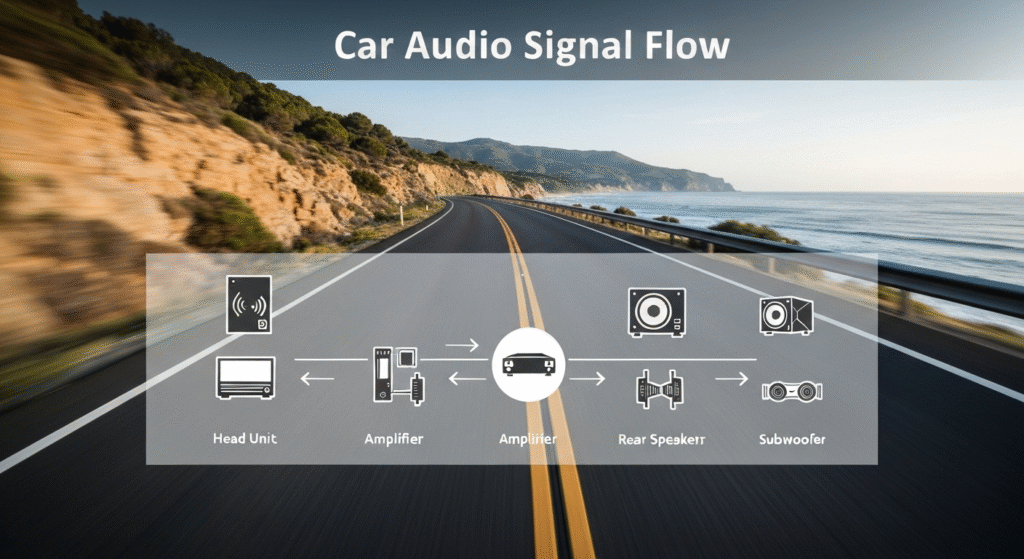
Now that you know the players, let’s see how they work together. The signal flow in a typical upgraded system looks like this:
- Source: You select a song on your Head Unit via Bluetooth.
- Signal Path: The head unit creates a clean, low-power audio signal and sends it out through the RCA cables connected to its pre-outs.
- Power Up: The RCA cables deliver that signal to your Amplifier. The amp boosts the signal strength significantly, providing clean power for each channel.
- Final Output: Speaker wire carries this high-power signal from the amplifier to your Speakers.
- Sound Creation: The speakers’ internal motors react to the electrical signal, moving the cones back and forth to create sound waves, filling your car with music.
The quality of the installation and wiring is just as important as the components themselves. Using the correct gauge of power wire for your amplifier and properly shielded RCA cables to prevent engine noise are non-negotiable for a clean-sounding system. For a client who recently installed a powerful system himself, we spent an hour just re-routing his RCA cables away from the car’s main power lines. That simple change eliminated a persistent and annoying alternator whine he couldn’t get rid of.
Frequently Asked Questions (FAQs)
What’s the first thing I should upgrade in my car audio system?
For the biggest impact on sound quality and features, the head unit is almost always the best place to start. A new head unit provides a cleaner signal, more power than stock, and modern features like Bluetooth and smartphone integration.
Do I need a subwoofer?
If you listen to music with deep bass (like hip-hop, EDM, or even rock) and feel that something is missing, then yes. A subwoofer is specially designed to reproduce the lowest frequencies that regular speakers can’t handle, adding depth and impact to your music.
What is RMS power really?
Think of it as “honest power.” It’s the measure of how much continuous power an amplifier can produce or a speaker can handle during normal operation. Always use the RMS rating to match your components, and largely ignore the “Peak Power” number.
Can I install a car audio system myself?
A simple speaker or head unit swap can be a great DIY project if you’re comfortable with basic tools and wiring. However, for more complex installations involving amplifiers and component speakers, a professional installer can ensure everything is wired safely and tuned correctly for the best possible sound. For more information on DIY installations, websites like Crutchfield offer excellent tutorials and vehicle-specific guides.
Conclusion
Building a great car audio system is a journey, not a destination. It starts with understanding that your head unit, amplifier, and speakers all play crucial roles in delivering the final sound. By upgrading even one of these components, you can make a noticeable improvement.
You now have the foundational knowledge to diagnose your current system’s weaknesses and make informed decisions about your next steps. Whether you start with a new head unit for better features, add an amplifier for clean power, or swap your speakers for more clarity, you are on the path to transforming your car from a simple mode of transportation into your personal concert hall. The key is to start with a goal, understand the basics, and build a system that you’ll enjoy every time you turn the key.

